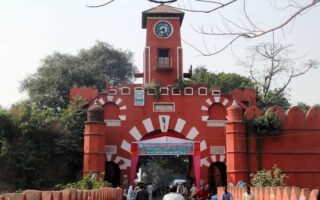The irony of life is that most of the time we take things for their face value. Many things we see, touch, feel, or experience turn out to be very different from our interpretation. With the passage of time, everything changes. Same is the case with the ruins of Vijayanagara city, which was once inhabited by people like us, in the present day Bellary district of Karnataka.
Location
The ruins of ancient Vijayanagara city are located near Tungabhadra river, at an altitude of 1,864 feet from sea level. The location of this historical site is considered to be a sacred place which was ruled by Kishkindha Empire.
There is also a Hanuman temple, Hanuman’s mother’s home, a holy water reservoir and homes of few other mythological figures.
History
Vijayanagara or the Town of Victory, is the largest city of the ancient times. With a population of 500,000, this town surpassed the number of residents in any part of the world in the sixteenth century.
The Dynasty of Vijayanagara was established by two brothers named Bukka and Harihara. Vijayanagara was chosen by Bukka as the capital city of the kingdom. It was during his reign that the kingdom flourished and expanded drastically.
Like any other region, the area falling under the Vijayanagara empire was in constant threat due to the repeated attacks by the Muslim emperors. In the mid-sixteenth century, several Muslim emperors who had formed the Deccan sultanate launched an attack and defeated the ruler of the kingdom.
Once the Muslim armies gained control of the town, they went on a destruction spree, leaving almost all the structures, including temples and residences, in a state of ruins. The city was never occupied or rebuilt after this defeat.
Structure
A portion of the town, marked between the Matanga Hill and the Hampi village has been termed as The Sacred Centre by historians.
Another portion of the town, separated from the Sacred Centre by a small valley, and extended till what can be called as the border of Kamalapuram, has been named as The Royal Centre by the historians. This name has been given due to the presence of ruins of palaces, temples, administrative buildings, etc.
The structures that survived despite the damages caused by the Muslim armies include:
Virupaksha Temple
Sometimes referred to as the Pampapati temple, this temple complex features two courts. It is still frequented by religious people who follow Virupaksha, an avatar of Lord Shiva.
Hemakuta Hill
This hill is located at the south of Hampi village. Visitors can find numerous temples in this hill, dating back to as old as 10th century. Some incomplete structures are also found in this hill.
Lakshmi Narasimha
Narasimha is an avatar of Lord Vishnu, the cosmic creator. A 6.7 metre high idol of Narasimha is the highlight, while the idol of Lakshmi, believed to be disfigured by vandals, was removed and kept at a museum in Kamalapuram.
The idol of Narasimha rests on Shesha Naag, a snake which is believed to be an avatar of God.
Krishna Temple
A temple partially in ruins can be seen towards the south of Hemakuta Hill. Construction of this temple was done by king Krishnadevaraya.
Vittala Temple
A 16th century temple, dedicated to an avatar of Lord Vishnu, this structure is located close to the village of Anegondi. Outside the temple, one can spot the stone chariot. The wheels of this chariot were movable, but the authorities decided to fix them with cement to avoid any damage.
Kodandarama Temple
This is another temple in the town, which is still used by the visitors. The statues of Lord Rama, Laxman and Rama’s wife Seeta can be seen inside the temple.
Ramachandra Temple
This temple features carvings on the outer walls that depict routine activities and scenes from festivals celebrated by the inhabitants.
Lotus Mahal
A palace meant solely for the royal women, this structure features distinctive architectural patterns adapted from Islamic architecture. Built entirely out of stone, this palace is totally different from the traditional structures in the town.
Pushkarani
Pushkarani is the stepped well, which was meant to be used by the royal women for bathing.
Underground Shiva Temple
This temple has a sanctum sanctorum and an assembly hall which features pillared corridors. The base of the temple is far from accessible during monsoon, as it gets submerged in water.
Elephant Stables
The elephant stables are located adjacent to an open field, which was used by the army troops for parades.
Dedicated as a World Heritage Site by UNESCO, the ancient town of Vijayanagara is one of the best historical places discovered in the Indian subcontinent.
What to See
Apart from watching the ruins of the ancient town, visitors can head to the archaeological museum in Kamalapuram. This museum showcases objects collected during the excavation of the town and idols of Goddesses as well.
How to Reach
The nearest airport from the ruins of Vijayanagara city is located in the town of Hubli, at a distance of 143 kilometres. This airport provides direct connectivity with Mumbai and Bangalore.
The nearest railway station from Hampi is located at Hospet, at a distance of approximately 13 kilometres. Direct trains are available to and from several important towns of India, making it easy for the tourists to plan their visit to Hampi and embark on it, too. Once you reach Hospet station, you can hire an auto rickshaw to reach Hampi.
Hampi is easily accessible through road transport as well. It is located at a distance of 350 kilometres from Bangalore, 150 kilometres from Hubli, 360 kilometres from Hyderabad and around 800 kilometres from Mumbai.
Visitors also have the option to rent bicycles, which cost Rs 100/- per day and allow you to commute around the town without getting stuck in traffic jams. On the other hand, visitors can hire a private cab which costs anywhere between Rs 800/- to 1200/- according to the make of the car and other factors.
